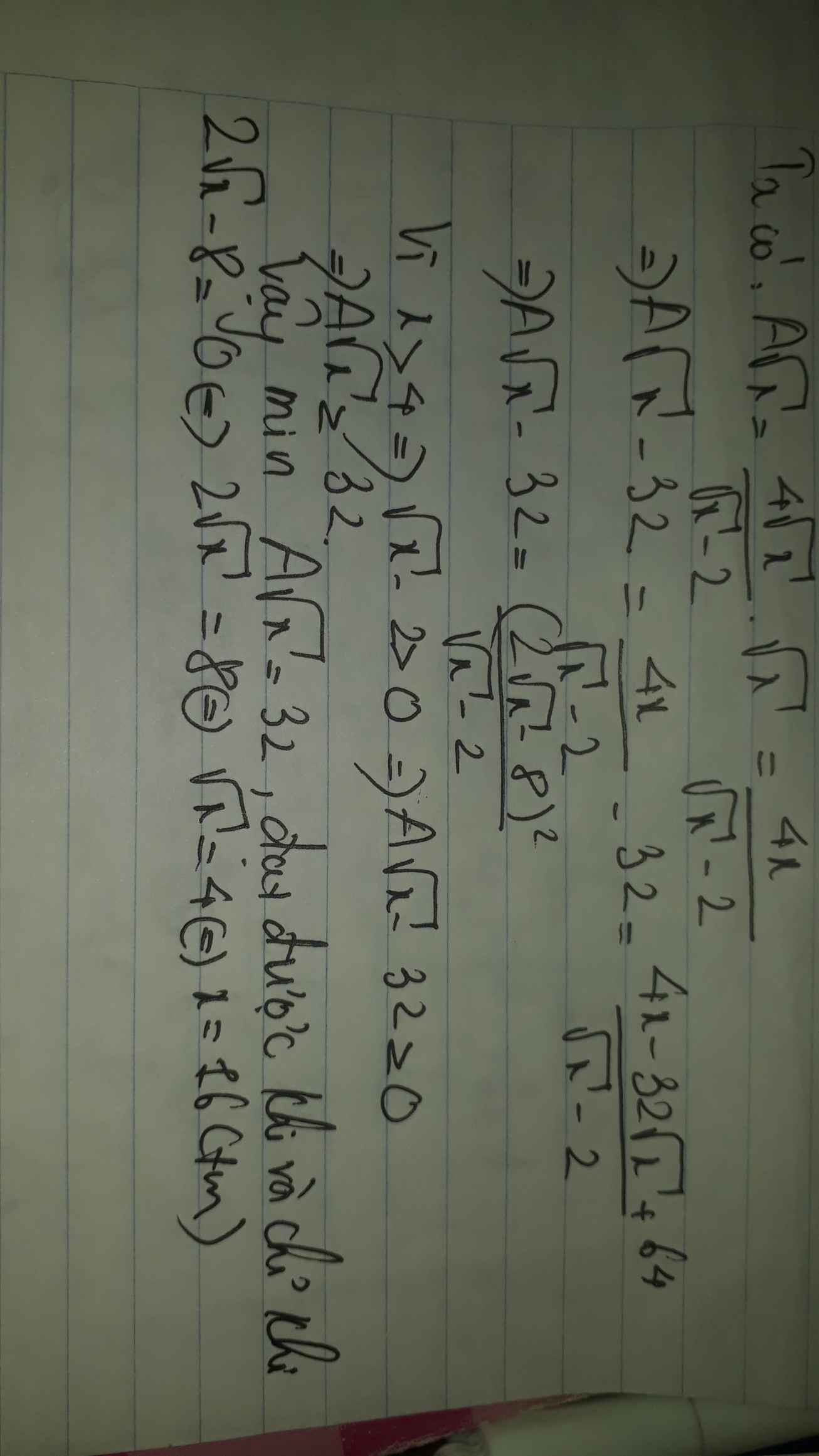Tìm giá trị nhỏ nhất của \(A=x+\sqrt{4-x^2}+x\sqrt{4-x^2}\)
Hãy nhập câu hỏi của bạn vào đây, nếu là tài khoản VIP, bạn sẽ được ưu tiên trả lời.


a: ĐKXĐ: \(\left\{{}\begin{matrix}x\ge0\\x\ne4\end{matrix}\right.\)
Ta có: \(P=\dfrac{\sqrt{x}}{\sqrt{x}+2}+\dfrac{2}{\sqrt{x}-2}-\dfrac{4\sqrt{x}}{x-4}\)
\(=\dfrac{x-2\sqrt{x}+2\sqrt{x}+4-4\sqrt{x}}{\left(\sqrt{x}-2\right)\left(\sqrt{x}+2\right)}\)
\(=\dfrac{\sqrt{x}-2}{\sqrt{x}+2}\)

Bài 5:
a: Thay \(x=4+2\sqrt{3}\) vào E, ta được:
\(E=\dfrac{\sqrt{3}+1-1}{\sqrt{3}+1-3}=\dfrac{\sqrt{3}}{\sqrt{3}-2}=-3-2\sqrt{3}\)
b: Để E<1 thì E-1<0
\(\Leftrightarrow\dfrac{\sqrt{x}-1-\sqrt{x}+3}{\sqrt{x}-3}< 0\)
\(\Leftrightarrow\sqrt{x}-3< 0\)
hay x<9
Kết hợp ĐKXĐ, ta được: \(\left\{{}\begin{matrix}0\le x< 9\\x\ne1\end{matrix}\right.\)
c: Để E nguyên thì \(4⋮\sqrt{x}-3\)
\(\Leftrightarrow\sqrt{x}-3\in\left\{-2;1;2;4\right\}\)
\(\Leftrightarrow\sqrt{x}\in\left\{4;5;7\right\}\)
hay \(x\in\left\{16;25;49\right\}\)
Câu 2:
a) Ta có \(x=4-2\sqrt{3}\Rightarrow\sqrt{x}=\sqrt{\left(\sqrt{3}-2\right)^2}=\sqrt{3}-2\)
Thay \(x=\sqrt{3}-1\) vào \(B\), ta được
\(B=\dfrac{\sqrt{3}-1-2}{\sqrt{3}-1+1}=\dfrac{\sqrt{3}-3}{\sqrt{3}}=1-\sqrt{3}\)
b) Để \(B\) âm thì \(\dfrac{\sqrt{x}-2}{\sqrt{x}+1}< 0\) mà \(\sqrt{x}+1\ge1>0\forall x\) \(\Rightarrow\sqrt{x}-2< 0\Rightarrow\sqrt{x}< 2\Rightarrow x< 4\)
c) Ta có \(B=\dfrac{\sqrt{x}-2}{\sqrt{x}+1}=1-\dfrac{3}{\sqrt{x}+1}\)
Với mọi \(x\ge0\) thì \(\sqrt{x}\ge0\Rightarrow\sqrt{x}+1\ge1\Rightarrow\dfrac{3}{\sqrt{x}+1}\le3\Rightarrow B=1-\dfrac{3}{\sqrt{x}+1}\ge-2\)
Dấu "=" xảy ra khi \(\sqrt{x}+1=1\Leftrightarrow x=0\)
Vậy \(B_{min}=-2\) khi \(x=0\)

\(A=\dfrac{\left(\sqrt{x}-2\right)^2+1}{\sqrt{x}-2}=\sqrt{x}-2+\dfrac{1}{\sqrt{x}-2}\\ \ge2\sqrt{\left(\sqrt{x}-2\right)\left(\dfrac{1}{\sqrt{x}-2}\right)}=2\cdot1=2\left(BĐT.cauchy\right)\)
Dấu \("="\Leftrightarrow\left(\sqrt{x}-2\right)^2=1\Leftrightarrow\sqrt{x}=3\Leftrightarrow x=9\)
\(A=\dfrac{x-4\sqrt{x}+5}{\sqrt{x}-2}=\dfrac{\left(\sqrt{x}-2\right)^2+1}{\sqrt{x}-2}=\sqrt{x}-2+\dfrac{1}{\sqrt{x}-2}\)
Áp dụng bất đẳng thức Cauchy cho 2 số dương:
\(A=\sqrt{x}-2+\dfrac{1}{\sqrt{x}-2}\ge2\sqrt{\dfrac{\sqrt{x}-2}{\sqrt{x}-2}}=2\)
\(minA=2\Leftrightarrow\sqrt{x}-2=1\Leftrightarrow\sqrt{x}=3\Leftrightarrow x=9\)

Với các số thực không âm a; b ta luôn có BĐT sau:
\(\sqrt{a}+\sqrt{b}\ge\sqrt{a+b}\) (bình phương 2 vế được \(2\sqrt{ab}\ge0\) luôn đúng)
Áp dụng:
a.
\(A\ge\sqrt{x-4+5-x}=1\)
\(\Rightarrow A_{min}=1\) khi \(\left[{}\begin{matrix}x=4\\x=5\end{matrix}\right.\)
\(A\le\sqrt{\left(1+1\right)\left(x-4+5-x\right)}=\sqrt{2}\) (Bunhiacopxki)
\(A_{max}=\sqrt{2}\) khi \(x-4=5-x\Leftrightarrow x=\dfrac{9}{2}\)
b.
\(B\ge\sqrt{3-2x+3x+4}=\sqrt{x+7}=\sqrt{\dfrac{1}{3}\left(3x+4\right)+\dfrac{17}{3}}\ge\sqrt{\dfrac{17}{3}}=\dfrac{\sqrt{51}}{3}\)
\(B_{min}=\dfrac{\sqrt{51}}{3}\) khi \(x=-\dfrac{4}{3}\)
\(B=\sqrt{3-2x}+\sqrt{\dfrac{3}{2}}.\sqrt{2x+\dfrac{8}{3}}\le\sqrt{\left(1+\dfrac{3}{2}\right)\left(3-2x+2x+\dfrac{8}{3}\right)}=\dfrac{\sqrt{510}}{6}\)
\(B_{max}=\dfrac{\sqrt{510}}{6}\) khi \(x=\dfrac{11}{30}\)
a)Ta có:A=\(\sqrt{x-4}+\sqrt{5-x}\)
=>A2=\(x-4+2\sqrt{\left(x-4\right)\left(5-x\right)}+5-x\)
=>A2= 1+\(2\sqrt{\left(x-4\right)\left(5-x\right)}\ge1\)
=>A\(\ge\)1
Dấu '=' xảy ra <=> x=4 hoặc x=5
Vậy,Min A=1 <=>x=4 hoặc x=5
Còn câu b tương tự nhé

Lời giải:
a. $y=\sqrt{x^2+x-2}\geq 0$ (tính chất cbh số học)
Vậy $y_{\min}=0$. Giá trị này đạt tại $x^2+x-2=0\Leftrightarrow x=1$ hoặc $x=-2$
b.
$y^2=6+2\sqrt{(2+x)(4-x)}\geq 6$ do $2\sqrt{(2+x)(4-x)}\geq 0$ theo tính chất căn bậc hai số học
$\Rightarrow y\geq \sqrt{6}$ (do $y$ không âm)
Vậy $y_{\min}=\sqrt{6}$ khi $x=-2$ hoặc $x=4$
$y^2=(\sqrt{2+x}+\sqrt{4-x})^2\leq (2+x+4-x)(1+1)=12$ theo BĐT Bunhiacopxky
$\Rightarrow y\leq \sqrt{12}=2\sqrt{3}$
Vậy $y_{\max}=2\sqrt{3}$ khi $2+x=4-x\Leftrightarrow x=1$
c. ĐKXĐ: $-2\leq x\leq 2$
$y^2=(x+\sqrt{4-x^2})^2\leq (x^2+4-x^2)(1+1)$ theo BĐT Bunhiacopxky
$\Leftrightarrow y^2\leq 8$
$\Leftrightarrow y\leq 2\sqrt{2}$
Vậy $y_{\max}=2\sqrt{2}$ khi $x=\sqrt{2}$
Mặt khác:
$x\geq -2$
$\sqrt{4-x^2}\geq 0$
$\Rightarrow y\geq -2$
Vậy $y_{\min}=-2$ khi $x=-2$

a: \(A=\dfrac{x-2+\sqrt{x}}{\sqrt{x}\left(\sqrt{x}+2\right)}\cdot\dfrac{\sqrt{x}+1}{\sqrt{x}-1}=\dfrac{\sqrt{x}+1}{\sqrt{x}}\)

\(A=\sqrt{x-2}+\sqrt{4-x}\ge\sqrt{x-2+4-x}=\sqrt{2}\)
\(A_{min}=\sqrt{2}\) khi \(\left[{}\begin{matrix}x=2\\x=4\end{matrix}\right.\)
\(y=4x^2+\dfrac{9}{x^2}-3\ge2\sqrt{\dfrac{36x^2}{x^2}}-3=9\)
\(y_{min}=9\) khi \(x^2=\dfrac{3}{2}\)
\(P=\dfrac{x-1}{4}+\dfrac{1}{x-1}+\dfrac{1}{4}\ge2\sqrt{\dfrac{x-1}{4\left(x-1\right)}}+\dfrac{1}{4}=\dfrac{5}{4}\)
\(P_{min}=\dfrac{5}{4}\) khi \(x=\dfrac{3}{2}\)
